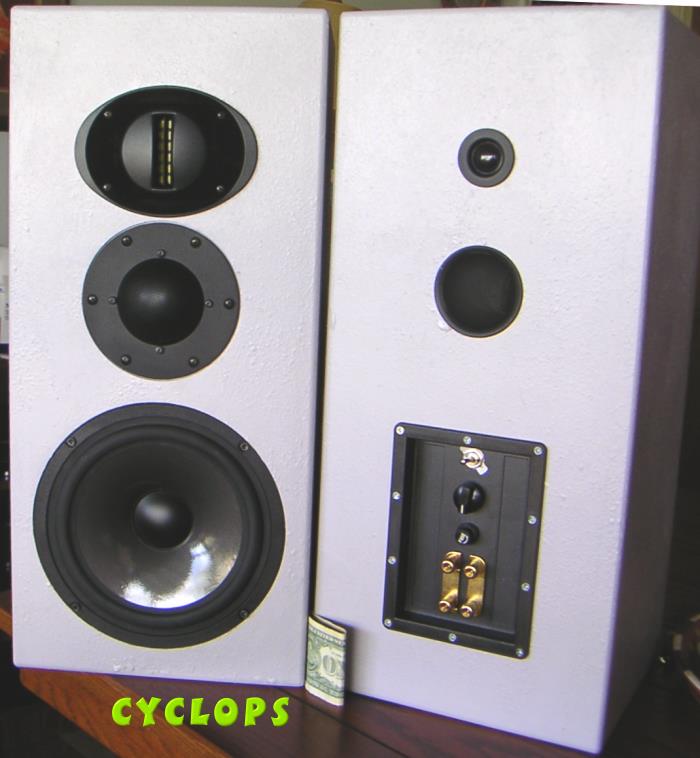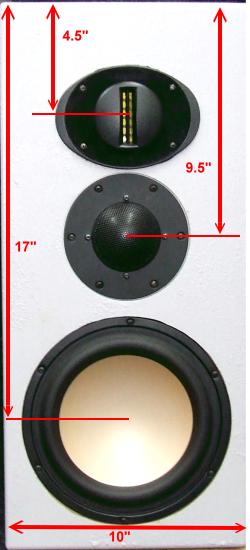
Last Update : 6 MAR 2008
Back to Lou's Home Page RAW DRIVER MEASUREMENTS HERE
- HiVi M8N 8" Woofer
- Dayton RS 52 Aluminum Dome Midrange
- Hi-Vi RT1E Kaldex Planar Tweeter
- Dayton NDF20-6 Rear Firing, textile dome Tweeter
- Estimated Eff: 87 db, 4 ohms nominal
- F3 40 hz in 23 liters, 1 7/8" D X 5.6" L vent.
- 22.5" High X 9.5" Deep X 10.25" Wide
Designer's Note:
The original Cyclops used the OEM Audax HP210Z2 8" woofer. I have since replaced them with the HiVi M8N. The writeup has been edited to reflect the M8N. Some original text has been preserved for continuity purposes. Construction photos show the "originals".
IMHO, the substitution of the M8 takes this design from cool experiment to a solid, smooth coherent "large bookshelf" speaker with very authoritative bass. It plays clean, reasonably loud, and needs no subwoofer to do an accurate job on a variety of music.
Now that I have that brassy cone, I may have to rethink that gray finish...
The Cyclops began life as an experiment. I felt like I needed to get rid of some drivers I've had around for awhile, and I felt I could handle another 3 Way.
The oval HiVi's were a closeout at PE. The are basically the RT1-C driver with a removeable faceplate. With a large foot print, and the need for a high crossover, a three way seemed like the only viable use for this beast. I think any of the current HiVi RT1 variants would work in this design. I believe that only the faceplates change -- the driver "cartridge" looks the same. (The RT1E is available from Madisound as of this writing.)
I considered several midranges from HiVi, Audax and a variety of close outs in the closet. I scrapped them all and decided to go with the RS52.
The original Audax HP210Z2 Aerogels were a closeout from Madisound about 3 years ago. Unfortunately, they were damaged badly and I needed to replace them. I chose the M8N because the thru hole and overall diameter were very close to the Audax. I have not seen many designs using the M8. T/S specs (and other designers) suggest a much larger "optimal" box. The HiVi spec sheet suggested a 22 liter box tuned to 35 Hz. Really close to my box. Even allowed me to use a longer version of the same port I had in the original. This configuration will give roughly a 3dB boost at 64 Hz. While not my usual box design, I thought it was worth a try. I needed to sand out the "thru" hole about 1/8", redo the rabbet with my router, and mount the M8.
I also had several big closeout terminal plates from PE. Two pair of binding posts, a 15 watt Lpad, fuse, and a SPST switch. (It was a "deal", don't ask). Back in my youth, I always liked "omni directional" speakers. I had some RTR towers with rear & top firing tweeters that I really liked. I decided to use the terminal plate and incorporate a rear firing tweeter that could be adjusted to suit the listener's desired "ambience" level. I chose a Dayton ND20F , and mounted it in the rear on the center axis of the HiVi. The ND20 is hooked into the LPad. I traded the SPST switch for a DPDT switch that will allow me switch polarity & phase on the rear tweeter.
Crossover Design & Measurements
I chose to measure at a distance of about 2 meters, using ground plane techniques. . Because I had no spares for the ribbons, I measured those with 48uF cap in series. Measurements HereI routed out a square opening to recess the HiVi "business end". I chose to leave the faceplate surface mounted. With the deep wave guide, the planar has a bit of horn loading. This mounting would also put the business end in roughly the same vertical plane as the RS52. I flush mounted the RS52 and the M8.
The HiVi measured fairly smooth, rolling off steeply at about 3000. The RS looked very much like the published specs. Smooth to about 7 kHZ before spiking into breakup mode.
The RS took a lot of work (and a lot of components). It winds up looking nicely symmetrical with effectively 4th order Linkwitz accoustical slopes on both sides. (3rd order electrical). Much as tried I couldn't get a single cap/coil combo to phase correctly on the low end. The M8/RS cross wound up at about 800. On the top end, the 4th order slope is steep enough to suppress the breakup mode on the RS52 without notch filters. The spilt padding resistors enables shaping of the slopes and phasing.
Though I tried to push it lower, the HiVi seemed happiest crossing at 4000. The RS can handle things up there just fine though. With this high cross point, the padding on the HiVi is fairly insensitive. I liked it boosted a bit. Even disconnected from rest of the circuit, the RS goes out high enough to make the box listenable.
The impedance profile is fairly benign. I couldn't flatten this out without deleterious effects on frequency response & phase. Though it goes pretty low at 10-20K, my cheapie digital Panasonic drove it quite happily. I would consider these 4 ohm boxes to be on the safe side. The lower bass is clearly around 8 ohms, so these should present no major problems.
For the rear fire ND20, I tried taking measurements with rear of the box about 10" from my garage door. The front three drivers looking much like the free air measures I have shown here. The ND20 FR was fairly flat, but very ragged, with no way to accurately measure phase.
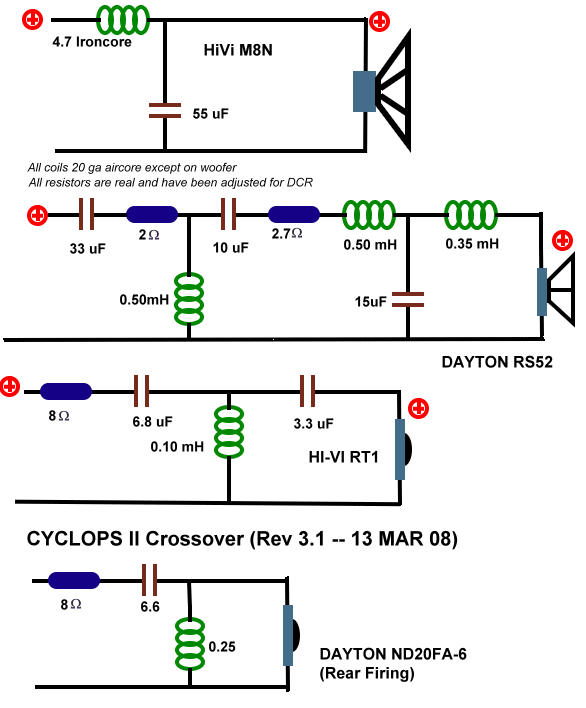
Listening Impressions (Revised 6 March 2008)
Overall, I think I got the balance right. The M8N is a dramatic improvement over the original Audax. Bass goes from "nice & polite" to "very punchy". The boost at 65 Hz is pretty much absorbed by baffle step correction and serves to help maintain sensitivity. It's still there though. Cue up something with honest bass, and the M8's hit hard with no slop. I didn't expect this box alignment to work, but it sure does -- nicely. It turns this little box into a slammin' speakah.
The RS52 is a very clean, detailed mid. Certainly is a difference between dome's and cones in this range. There's very nice detail, with crisp piano & keyboards. Superb on female vocals, and strings. The imaging holds up very nicely off axis. Very "airy", a bit forward, but quite smooth and effortless.
The RT1 has nice sparkle and air. Like the other ribbons I've used, I can stand this a bit hotter than I normally voice domes. The wild looking face plate seems to do it's job. Not much vertical dispersion, but pretty smooth off axis in the horizontal plane. There is a definite sweet spot -- that is easily overcome with ambience tweeter. I still like the Neo3PDR better than this HiVi for roughly the same money -- but the Neo3 is a bit tougher to mount.
Despite the apparently low impedance in 2000+ range, I've run these extensively on my Panasonic XR50 system at reasonably high levels. I found no problems with the quality of sound. I suspect the high sensitivity and relatively low power draw at higher frequencies makes the Cyclops fairly benign. I'd still call this a 4 ohm speaker.
I didn't have much time to twiddle with the ambience tweeter. Run full out the effect is kind of harsh and blaring, turned down a few dB, and the effect is really pretty cool. The stage opens up and becomes huge, though details of instrument placement are quickly lost. Closer to the backwall, the effect is more dramatic in contrast. While I was listening in a very bright room, I could see that twiddling with the ambience setting would give one a lot of control. The tradeoff seems to be sound from everywhere vs lost spatial cues. The purists will obviously pooh-pooh the rear tweeter, but I think it has real potential for party mode and for background tunes while puttering around the house.
How would I rank the Cyclops? If the Cryolites were a 100, I'd give these a 110 (Revision 3, with ambience), the Schticks a 105, the KanToos a 95. Yes, the drivers are a bit more than bargain basement and the crossover has a few more components than some. What do you get for that? A very refined, compact 3 way monitor capable of great bass.
Extended Listening and the Ambience Effect
I got together with a one of my "golden ear" audiophile friends for more listening. (A symphony musician with Accuton boxes, custom built amps, room treatments...) We set up the Cyclops on stools well out in the room and played quite a bit with the "ambience" settings. On Xavier's equipment, the Cyclops sounded very well balanced, a bit thicker on the bottom than with my Panny. After a lot of tweaking, we found that having the ND20 just barely audible was the best level. The phasing of the tweeter seemed quite significant. (Alas, I didn't mark the switch for in/out of phase). With the "correct" phase, increased depth and width of stage is quite dramatic. Speakers truthfully disappear into a cohesive sonic soundstage. "Incorrect" phasing seems to muddy the sound. With rear levels set too high, the effect is smeared and the sound becomes harsh and blaring.
When dialed in right, I think the ambience tweeter has the potential to throw a huge soundstage. I believe the "correct" phase and level will be highly room dependent. I suspect levels 4-8 dB down will be preferrable for most folks. So is it worth it? I'd say so. For $15-$20 in parts, you can change the character of the speaker on the fly. Definitely a "must do" for inveterate tweekers.
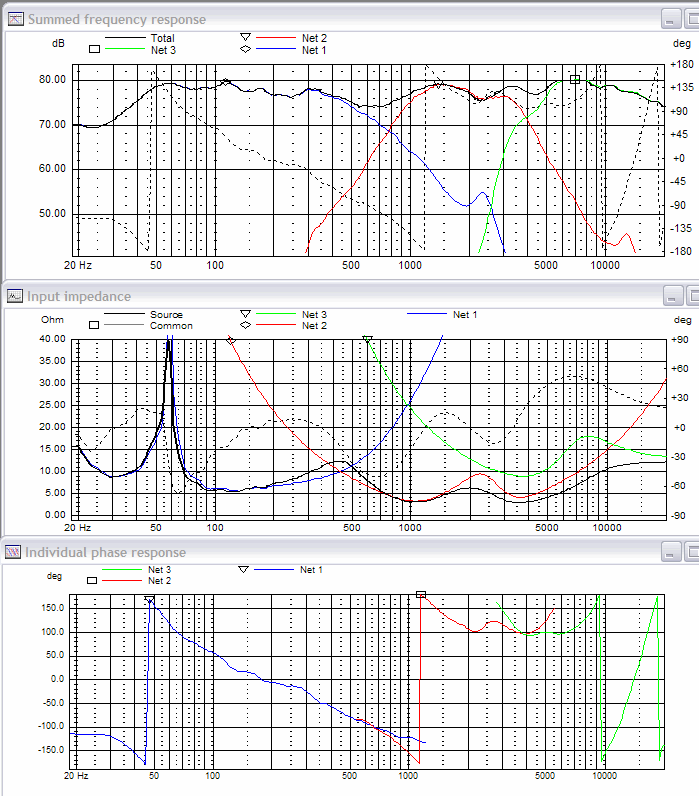
Final Assembly (From Original Version)
I ordered a gallon of Duratex (in a custom color ) from AcryTech.com. This is a waterbased urethane coating designed for prosound boxes. It covers in two coats (base + texture) and dries like truck bed liner -- but without any stink, (water cleanup). Supposed to be waterproof, bash resistant, and otherwise super durable. The gallon I got was the consistency of yogurt. After sanding all the box edges flush, I ran a 1/4" roundover bit around all the edges. I applied the Duratex with a small long nap roller for the seal coat. I used the Duratex textured roller cover for the second. The texture coat "blobs" are a little large for this size box. (Looks like drywall texture). It has a very nice sheen, and looks pretty contemporary from 2-3 feet. My wife liked it enough to OK moving these into the living room for testing. Pretty nice, very easy. If Dan wanted to package in quarts, I think a lot of builders would be interested. (I may eventually add some hardwood, or contrasting, "cheeks". I'll sand some of the bigger blobs when they've dried a couple days).
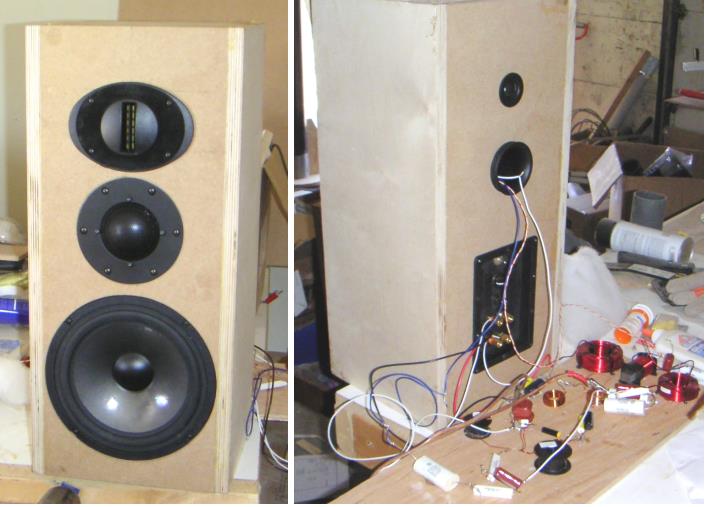
I fed the rear tweeter from the top two posts. First to the outside poles of a DPDT switch. By crossing the wires, I can invert the polarity of the tweeter. From the center poles of the DPDT switch, the signal goes thru the crossover, thru the rotary LPad on the back plate, and finally to the ND20. The main crossover is hooked only to the bottom two binding posts.
I used a cross brace at the mid-woofer line on the baffle, and just above the binding post box on the rear. Three sides were lined with accoustic foam and the remainder of the box lightly stuffed with Dacron. With low woofer crossover, and a sealed midrange, not much probability of standing waves.
Original Cyclops
